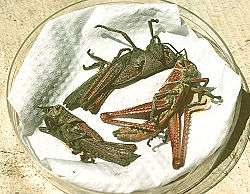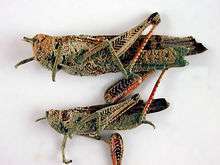Metarhizium acridum
Metarhizium acridum[1] is the new name given to a group of fungal isolates that are known to be virulent and specific to the Acrididea (grasshoppers). Previously, this species has had variety status in Metarhizium anisopliae (var. acridum[2]); before that, reference had been made to M. flavoviride or Metarhizium sp.[3] describing an "apparently homologous and distinctive group" of isolates that were most virulent against Schistocerca gregaria (desert locust) in early screening bioassays.
| Metarhizium acridum | |
|---|---|
 | |
| Red locust with sporulating standard isolate of M. acridum | |
| Scientific classification | |
| Kingdom: | Fungi |
| Division: | Ascomycota |
| Class: | Sordariomycetes |
| Order: | Hypocreales |
| Family: | Clavicipitaceae |
| Genus: | Metarhizium |
| Species: | M. acridum |
| Binomial name | |
| Metarhizium acridum (Driver & Milner) J.F. Bisch., Rehner & Humber (2009) | |
| Synonyms | |
|
Metarhizium anisopliae var. acridum Driver & Milner | |
Biology
M. acridum almost exclusively infects grasshoppers in the suborder Caelifera of the Orthoptera. Various research groups, including the international LUBILOSA programme (which developed the product 'Green Muscle') have identified and addressed key technical challenges for exploitation of microbial control agents, including isolate selection, mass production, and delivery systems (formulation and application).[4] Insect control (mortality) depends on factors such as the number of spores applied against the insect host, the formulation[5] and weather conditions.[6] Oil-based formulations allow the application of fungal spores under dry conditions, and are compatible with existing ultra-low volume (ULV) application techniques for locust control.
M. acridum only targets and affects grasshoppers and locusts. Researchers believe that this has to do with the Mest1 gene which is not present in M. acridum. By taking a strain of M. robertsii that has a nonfunctioning Mest1 gene, researchers found that the mutant was only able to infect grasshoppers and locusts which is consistent with M. acridum. This allows the initiation of the infection process on the specific targets. The expression of Mest1 in the parasite M. acridum is triggered by substances that are only found on the waxy coat of the grasshoppers, which explains why this parasite specifically only targets grasshoppers and locusts.[7]
M. acridum is currently under consideration by the USDA for release in the Western U.S. for control of native grasshoppers and crickets.[8]
Important isolates
- IMI 330189 (= ARSEF 7486) is the ex-type of the species, originally collected from Niger: the active ingredient of 'Green Muscle'.
- CSIRO FI 985 (= ARSEF 324) is an Australian isolate: the active ingredient of 'Green Guard'.
- EVCH077 (= IMI 382977) has been isolated from an unidentified grasshopper in Benin: the active ingredient of 'NOVACRID'.
Gallery
.jpg)
 CSIRO isolate
CSIRO isolate
References
- Bischoff J.F.; Rehner S.A. & Humber R.A. (2009). "A multilocus phylogeny of the Metarhizium anisopliae lineage". Mycologia. 101 (4): 512–530. doi:10.3852/07-202. PMID 19623931.
- Driver, F.; Milner, R.J. & Trueman, W.H.A. (2000). "A Taxonomic revision of Metarhizium based on sequence analysis of ribosomal DNA". Mycological Research. 104 (2): 135–151. doi:10.1017/S0953756299001756.
- Bateman, R.P.; Carey, M.; Batt, D.; Prior, C.; Abraham, Y.; Moore, D.; Jenkins, N.; Fenlon J. (1996). "Screening for virulent isolates of entomopathogenic fungi against the desert locust, Schistocerca gregaria (Forskål)". Biocontrol Science and Technology. 6 (4): 549–560. doi:10.1080/09583159631181.
- Lomer, C.J.; Bateman, R.P.; Johnson, D.L.; Langewald, J. & Thomas, M. (2001). "Biological Control of Locusts and Grasshoppers". Annual Review of Entomology. 46: 667–702. doi:10.1146/annurev.ento.46.1.667. PMID 11112183.
- Burges, H.D., ed. (1998). Formulation of microbial biopesticides, beneficial microorganisms, nematodes and seed treatments. Dordrecht, Netherlands: Kluwer Academic. p. 412 pp. ISBN 0-412-62520-2.
- Thomas, M.H. & Blanford, S. (2003). "Thermal biology in insect-parasite interactions". Trends in Ecology and Evolution. 18 (7): 344–350. doi:10.1016/S0169-5347(03)00069-7.
- Wang, S; Fang, W; Wang, C; St; Leger, RJ (2011). "Insertion of an Esterase Gene into a Specific Locust Pathogen (Metarhizium acrid) Enables It to Infect Caterpillars". PLoS Pathog. 7 (6): e1002097. CiteSeerX 10.1.1.291.2854. doi:10.1371/journal.ppat.1002097.
- "Rangeland Grasshopper and Mormon Cricket Program". USDA-APHIS. Archived from the original on 9 December 2012. Retrieved 20 January 2011.